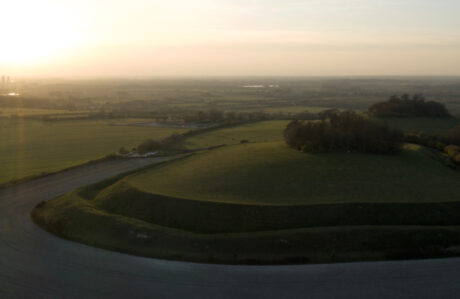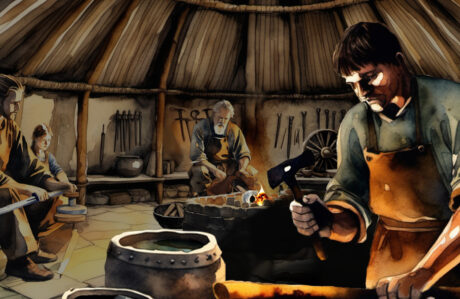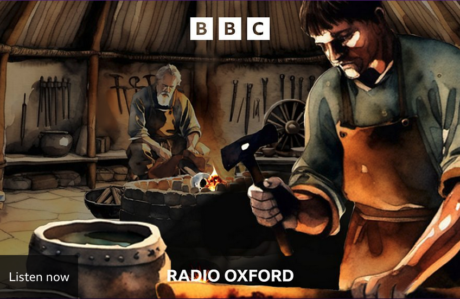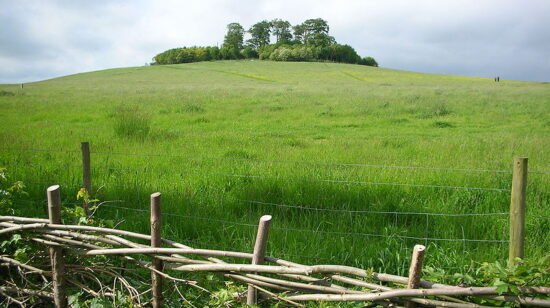
Everyone’s heard of China’s terracotta army. Haniwa are a bit like those guys, but with a lot more character. Credit: Tokyo National Museum
Beginning around 300 AD., the archipelago we now know as Japan saw an explosion in the construction of large-scale burial mounds, and enigmatic ceramic figures called haniwa were produced to accompany the dead. But what exactly are they, what are their origins, and how much fun can they possibly be?
12,000 years ago, Japan was inhabited by the Jomon people. They were hunter-gatherers, and were among the first in the world to start producing pottery.The ceramic figures of this period had emphasised sexual characteristics, which suggests they were used as symbols of fertility. Jomon pottery is exquisitely unrestrained and Jomon ‘dogu’ figurines have emphasised eyes, breasts, and markings, which may indicate a full body tattoo. Unlike haniwa, these figurines are found in settlements, not graves.
Over time, the Jomon hunter-gatherers were replaced by, or transitioned into, a rice-farming culture known as the Yayoi. Yayoi pottery lacks the imaginative flair of Jomon. Instead, the Yayoi people used their skills to make weapons, bells, and mirrors out of bronze.

Credit: Tokyo National Museum
They still made figures, but they are neither as intricate as the Jomon figurines, nor have the size or variability of the haniwa.

Credit: Tokyo National Museum
As the populations of these first villages grew, they also became more unequal. In the period between 250 A.D and 538, an elite class formed, with clan chieftains and their warriors exerting control over greater amounts of territory and when they died, they were buried in massive mounds called ‘kofun’, which in Japanese literally means ‘Old Tomb’.
Accompanying the dead in these massive tombs were sometimes hundreds of clay figurines, not unlike the Terracotta army of the Qin emperor. But at 1.85-2m tall, those guys tower over even the tallest haniwa, which is only 1.5 metres tall. So, who made these haniwa, and why?

What we do know is that they were made by professional pottery guilds which supplied the market for clay death servants, but the haniwa’s role in the funerary ritual isn’t entirely clear.
One of the oldest written sources in Japan, the Nihonshoki (literally ‘The Chronicle of Japan’), tells the story of an emperor whose younger brother died. When they buried him, they buried all his servants with him! The wailing annoyed the Emperor so much, he ordered that clay people be buried instead.
Whether or not this story is true, or just an amusing anecdote, the most likely interpretation is that the haniwa’s original function was to stop erosion – a retaining wall of clay buried at intervals kept the sides of the burial mounds from slipping.
In fact, the earliest haniwa were simple clay buckets…

Credit: Tokyo National Museum
But over the generations, the potters flexed their creative muscle and started producing haniwa houses, or personal shrines where the soul of the deceased could live.

Credit: Tokyo National Museum
Then came the haniwa horses…

Credit: Tokyo National Museum
But also chickens…

Credit: Tokyo National Museum
Boar…

Credit: Tokyo National Museum
And dogs (oh my!)

Credit: Tokyo National Museum
By far the most charming are the human figures, which range from somewhat realistic to outright strange! Predominant among these are the warriors:

Credit: Tokyo National Museum
But they aren’t all so fierce. In fact, some of them appear to have retired:

And judging by some of the other haniwa, the dead liked to be entertained! There is music…

Credit: Tokyo National Museum
There is dancing!

Best of all, there is booze! (as long as you like saké)

Of all the haniwa, the warriors tend to be the most detailed, which may be due to their role as protectors, or even the fact that they are meant to represent real people. Others seem to represent a role or occupation. This minimalism may be representative of nature spirits or abstract concepts (like song), which are otherwise hard to represent.

Credit: Tokyo National Museum
And so it seems that haniwa were multi-functional: they prevented erosion, they magnified the status of the deceased, they also reflected their interests in life, as well as their desires in death.
Today, their influence goes far beyond the archaeological; from video games to children’s cartoons like Kirby, Animal Crossing, and Anpanman, they make regular appearances in contemporary Japanese culture.

Maybe it’s their charm, maybe it’s their enigmatic nature, but the legacy of the haniwa looks set to endure. Long live the haniwa!
 Scott Chaussée is a PhD student at the Institute of Archaeology, University College London. Originally from Kansas, he lived in rural northern Japan for two years. From archaeology to gaming, his interests span at least 12,000 years! You can find him on Twitter @S_ChausseeArch
Scott Chaussée is a PhD student at the Institute of Archaeology, University College London. Originally from Kansas, he lived in rural northern Japan for two years. From archaeology to gaming, his interests span at least 12,000 years! You can find him on Twitter @S_ChausseeArch
Love archaeology?
DigVentures was born from a mission: to connect people who love archaeology with opportunities to DO archaeology. Together, we're making groundbreaking new discoveries that everyone can be part of, and creating archaeology content that we can all share, learn from and enjoy. Wherever you live and whatever your background, you can be part of it too.
Become a Subscriber









There are no comments on this post yet. Be the first!